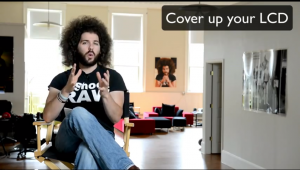4 Tips to Becoming A Better Photographer
I know some of these may seem kind of simple, but if you really think about them and put them into action, you will see results.
I can not stress enough that practice has made me better and can do the same for you. Mind you, I was practicing at a time before digital was affordable, where I was limited to 36 shots and could not see my results instantly. I am not saying you are at a disadvantage for shooting digital, but I can say you can borrow from the past to help you learn in the future.
1. Cover up your LCD screen with an index card and some tape so you can avoid seeing your settings or the images you capture. The challenge here is that it forces you to use your light meter to determine your settings. Limit yourself to 36 shots, just like we used to do with film, when we were limited to the amount of frames per roll. Only when you’re done shooting, either at the end of your photo shoot or when you reach 36 images, should you sit down and review the results. You can learn so much just from waiting until the end to review your results, even if your shots are not to your liking. Imagine how you will feel when the majority of your images are keepers and you didn’t rely on looking at the LCD screen after every shot.
2. Don’t be afraid to learn from other photographers. There is nothing better than being able to pick a professional photographer’s brain. If you find one who is willing to share their knowledge, you stand to learn a lot! I am not saying you should only look for professionals, either. Look for other photographers with similar skill sets as yourself and start a photo club. Just from the discussions and photo excursions you can plan, you will all continue to learn.
3. See the world around you and capture it with whatever camera you have, or just capture it with your mind. When you start to see images around you and try to figure out their settings, you are learning. I walk around and try to guess what the settings would be for the room I am in, along with what lenses I would use. Training yourself to see the world that is around you will allow you to get your settings correct when you do have a camera in your hand. As I said, capture the world with whatever camera you have. No matter whether it’s in a cell phone or a top-of-the-line DSLR, a great image is a great image, no matter how it’s captured.
4. This one always seems to get some feathers ruffled; I personally do not crop my work, and have not since my high school teacher said “crop in the camera, not in the darkroom.” This made instant sense to me. He preached that getting it right in the camera not only saves you time in the darkroom and at post-processing, but it saves your image quality. The same loss of quality occurred with film as it does with digital images when you crop. I say, challenge yourself not to crop. Go on a photo shoot and every time you say to yourself, “I will crop this in Post,” take a few steps closer or change to the proper lens to capture that image.
My suggestion is to try all of these out over the next month. Accept the challenge and tell me the results. What did you learn from the experience?




